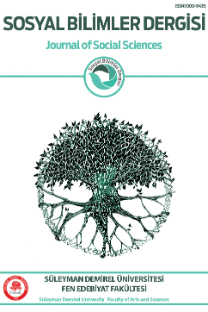Mahpus Öğrencilerin Benlik Sunumları: Dramaturjik İlkeler, Damga ve Total Kurum
Benlik, Damga, Dramaturji, Mahpus Öğrenci, Total Kurum
The Self-presentation of Imprisoned Students: Dramaturgical Principles, Stigma and Total Institutions
Identity, Stigma, Dramaturgy, Imprisoned Student, Total Institution,
___
- Behan, C. (2014). Learning to escape: Prison education, rehabilitation and the potential for transformation. Journal of Prison Education and Reentry, 1(1), 20-31.
- Bourdieu, P. (1999). Understanding. P. Bourdieu (Ed.), The weight of the world: Social suffering in contemporary society (s.607-626) içinde. California: Stanford University Press.
- Crewe, B. (2006). ‘Male prisoner’ orientation towards female officers in an English prison’. Punishment & Society, 8(4): 395-421.
- Crewe, B. (2007). The sociology of imprisonment. Yvonne Jewkes (Ed.). Handbook on Prisons (s.123-151) içinde. Willian Publising, Devon.
- Cuff, E. C., Sharrock, W.W. ve Francis, D.W. (2013). Sosyolojide perspektifler. (Ümit Tatlıcan, Çev.), İstanbul: Say Yayıncılık.
- Goffman, E. (2009). Günlük yaşamda benliğin sunumu, (Barış Cezar, Çev.), İstanbul: Metis Yayınları.
- Goffman, E. (2014). Damga örselenmiş kimliğin idare edilişi üzerine notlar. (Ş. Geniş, L. Ünsaldı ve S. N. Ağırnaslı, Çev.), Ankara: Heretik Yayınları.
- Goffman, E. (2016).Tımarhaneler: Akıl hastalarının ve kapatılmış diğer kişilerin toplumsal durumu üzerine denemeler. (Ebru Arıcan, Çev.), Ankara: Heretik Yayınları.
- Goffman, E. (2017). Kamusal alanda ilişkiler: Toplu yaşamın mikro incelemeleri. (M. Fatih Karakaya, Çev.), Ankara: Heretik Yayınları.
- Hackman, K. M. (1997). Correctional education-challenges and changes. Journal of Correctional Education, 48(2), 73-77.
- Hughes, E. (2000). An inside view: Prisoners’ letters on education. D. Wilson and A. Reuss (Eds.). Prison(er) education stories of change and transformation (s.138-157) içinde, Winchester: Watersidepress.
- MacGuinness, P. (2000). Dealing with time: Factors that influence prisoners to participate in prison education programmes. D. Wilson and A. Reuss (Eds.). Prison(er) education stories of change and transformation (s.83-105) içinde. Winchester: Watersidepress.
- Nichols, Helen (2016). An Inquiry into adult male prisoners’ experiences of education (Unpublished doctoral dissertation). The University of Hull at Cottingham Rd, England.
- Reuss, A. M. (1997). Higher education & personal change in prisoners (Unpublished doctoral dissertation). The University of Leeds at Leeds, UK.
- Sykes, G. M. (1958). The society of captives. New Jersey: Princeton University Press.
- Turner, J., Beeghley, L. ve Powers, C.H. (2010). Sosyolojik teorinin oluşumu.(Ümit Tatlıcan, Çev.), İstanbul: Sentez Yayıncılık.
- Wallace, R. A. ve Wolf, A. (2012). Çağdaş sosyoloji kuramları: Klasik geleneğin genişletilmesi. (M. Rami Ayas ve Leyla Elburuz, Çev.), Ankara: Doğu Batı Yayınları.
- ISSN: 1300-9435
- Yayın Aralığı: Yılda 3 Sayı
- Başlangıç: 1995
- Yayıncı: Süleyman Demirel Üniversitesi, Fen-Edebiyat Fakültesi
Şarhöyük’ten Bir Erken Tunç Çağ Mührü
Mahmut Bilge BAŞTÜRK, Yeliz KAYA
Geçmişten Günümüze Şekillenen Çocukluk Algısı ve Çocuk Yetiştirme Pratikleri
Mahpus Öğrencilerin Benlik Sunumları: Dramaturjik İlkeler, Damga ve Total Kurum
Hasan Hüseyin AYGÜL, Gökçe ÇELİK, Alara Fulya ŞENSOY
Yerli Sosyolojide Science Sociale Etkisi: Türk Sosyoloji Cemiyeti’nin 1957 İlmi Kongresi
Pisidia Bölgesi’nde Roma İmparatorluk Dönemi (MS 1.-3. yy) Sikke Dolaşımı
Yıldırım ATAYETER, Uğur TOZKOPARAN, Onur YAYLA
Hasan Ali Toptaş’ın Kuşlar Yasına Gider Romanında Baba Figürü
CALOUSTE SARKİS GULBENKIAN VE KOLEKSİYONU
Foça Çanak Koyu Sualtı Araştırmaları: İlk Bulgular
Mehmet Emre OKAN, Murat FIRAT, Cebrail BAYDAN
Rosenberg'in Siperde Şafak Vakti Şiirinin Tartışmacı Analizi
